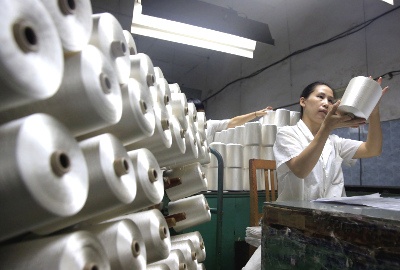 Imagine trying to sell a pair of pants that has a crooked zipper, a hole in the knee, untrimmed threads hanging off the bottom and one pant leg longer than the other. Sounds a bit like a Frankenstein creation, right? When it comes to manufacturing garments, it can seem like there are endless opportunities for production to go wrong.
Imagine trying to sell a pair of pants that has a crooked zipper, a hole in the knee, untrimmed threads hanging off the bottom and one pant leg longer than the other. Sounds a bit like a Frankenstein creation, right? When it comes to manufacturing garments, it can seem like there are endless opportunities for production to go wrong.
Are you going to find all of these quality issues in a single unit? Probably not. But sometimes just one serious quality defect is enough to render your product unsellable.
You can prevent most quality issues from happening in the first place by taking the time to clarify product requirements before production. But inevitably, you’re bound to discover some defects in your finished goods, especially when manufacturing a labor-intensive product like garments. That’s why most garment importers insist on some form of product inspection to confirm product quality before shipping.
So what’s the best approach for conducting quality control inspection for garments? Many garment importers choose to hire third-party inspectors to help them manage product quality, but your situation may call for another approach (related: How Betabrand Limits Quality Defects to Delight Their Garment Buyers [Case Study]). Let’s take a closer look at this and other options for QC inspection to help you determine which is best for you.
Relying on factory QC staff for quality control inspection for garments
If you’ve built a strong relationship with a supplier that has consistently met your quality standards, relying on factory QC staff to perform inspection might be a suitable option.
Any reputable supplier should be performing their own quality control checks before shipping, whether at the factory or some other facility. Most factories have dedicated quality control staff who wear a unique armband or uniform to make it easy to identify them. They also typically report to different supervisors than regular production workers.
It can be tempting to eliminate overhead inspection costs from your budget by relying on your supplier to check the goods before shipping. But more experienced garment importers prefer to visit and inspect on their own or send a trusted agent on their behalf, rather than leaving quality in the hands of their suppliers. There are several disadvantages to entrusting your supplier to quality control.
Potential conflict of interests between short-term gains and long-term customers
Suppliers sometimes put their own interests ahead of their customers’, which should be a major consideration with self-inspection. Your supplier will need to spend time and money to address any defects or other issues found during inspection. Rather than invest further in your order through corrective actions, your supplier may prefer to ship the goods and move on to fulfilling their next customer’s order.
Suppliers sometimes mistakenly overlook issues or misunderstand requirements
Another risk of relying on self-inspection is that factory staff might mistakenly overlook quality issues. Quality issues can often arise when a supplier misinterprets their customer’s requirements, often due to language barriers or cultural differences (related: Why You Can’t Assume Chinese Suppliers Always Understand Requirements). For example, although you’ve provided sizing charts with tolerances, your supplier might mistakenly apply the wrong measuring methods or standards.
Little or no reporting following inspection
Perhaps the biggest drawback with supplier self-inspection is the general lack of transparent reporting and communication during the process. It’s hard to be confident in the inspection method when you’re somewhat blindly relying on your supplier to check their own work. Likewise, you’ll typically have limited assurance that the factory has addressed any problems found.
You’re left waiting to receive the finished goods before confirming whether they actually meet your standards. And if they don’t, you may need to scramble to fix costly problems or refund your customers for unsellable goods.
Conducting quality control inspection for garments with full-time inspectors
You may choose to hire one or more full-time inspectors to assist you in managing product quality locally. Importers typically hire full-time inspectors on a salary basis to regularly visit their supplier’s factory and report on the quality and condition of their shipments. Several advantages of hiring full-time QC staff abroad include:
- Ease of management and training. Some garment importers find full-time inspectors easier to manage than third-party inspectors or the factory’s own QC staff. As their direct employer, you generally have complete control over training full-time inspectors to follow your processes and adhere to your policies.
- Consistent reporting. Since inspectors will be working exclusively for you, you have greater assurance that they’ll use the same garment inspection methods and procedures for every inspection. They’re also typically very familiar with your products and the history of potential quality issues related to them.
- Lower costs than third-party inspection when an inspector is needed regularly at one particular facility.
- Smooth communication. Full-time inspectors are usually native speakers of the local language, which can help to smooth communication about your product requirements.
Garment importers often enjoy relatively more control over the inspection process when hiring full-time QC staff. But there are a couple of compelling reasons why you may not want to hire a full-time inspector.
Higher costs when paying staff a salary for infrequent inspections
According to a 2017 report by Kelly Service, quality managers in China earn an annual salary of between $29,400 and $58,800. If you need a dedicated inspector to regularly visit one or more factories in the same area, hiring a salaried inspector could be relatively inexpensive. But a full-time inspector can be very expensive if you need inspections infrequently or at various facilities that are a considerable distance apart.
If you need a dedicated inspector to regularly visit one or more factories in the same area, hiring a salaried inspector could be relatively inexpensive. But a full-time inspector can be very expensive if you need inspections infrequently or at various facilities that are a considerable distance apart.
Whereas you can contract a third-party inspector only when you need them, a full-time inspector with a salary is costing you money even when they’re no inspections needed. And consider the added cost of transportation for a full-time inspector that needs to travel from one city to another.
Corruption risks when repeatedly sending the same inspector to a factory
Outside of costs and logistical hassles, there are potential integrity issues of using the same inspector for every inspection. Inspectors often work in close quarters with factory staff and managers when conducting inspections. The longer the same inspector works in a factory, the more likely they are to form a close relationship with factory staff. This familiarity can compromise your inspector’s integrity, leading to unreliable reporting.
If you can’t keep your inspectors independent from the factory, you might not get your money’s worth or adequately protect your quality.
Personally visiting or sending a representative abroad to conduct inspection
If you have the resources to visit your supplier, visiting the factory yourself early on can be helpful to foster a strong business relationship (related: 3 Tips for Stronger Supplier Relationships). When it comes to inspection, traveling to your supplier’s facility yourself offers a few benefits, including:
 An opportunity to informally audit the facility. Any audits should typically occur before starting to work with a supplier as part of the screening process. But visiting the facility for inspection gives you the opportunity to spot any potential problems before they affect your business.
An opportunity to informally audit the facility. Any audits should typically occur before starting to work with a supplier as part of the screening process. But visiting the facility for inspection gives you the opportunity to spot any potential problems before they affect your business.- Greater control when inspecting the first order from a new supplier. By being present to inspect the first order, you’re better prepared to respond to any issues immediately. Instead of waiting to see a report, you can address findings with your supplier directly on-site.
- Training QC staff on special inspection procedures or criteria for your garment products and coaching them on any specific requirements you have.
But that doesn’t mean you need to personally visit the factory, or send a representative from your company, to conduct quality control inspection for your garments. Let’s look at common reasons why other approaches to product inspection might be better for you.
Higher costs and inconvenience with traveling abroad
For most garment importers operating abroad, it would be quite expensive and inconvenient to travel internationally multiple times a year. Especially if you’re a smaller importer, having to travel to a supplier in Vietnam, China or India for several days can hinder other important tasks in your business. And depending on the factory location, you may be dependent on translators to communicate with factory staff. This can raise your risk of miscommunicating your requirements.
Lack of familiarity with professional inspection procedures
The most common reason garment importers might insist on performing their own inspection is that they understand their product requirements and their customers better than factory staff or outside QC inspectors. But familiarity with a product and knowing how to properly inspect it are too very different competencies. And many garment importers are unfamiliar with specific product inspection protocols and standards.
For example, professional inspectors typically use one of several acceptance sampling standards that offer efficient and definitive inspection results (related: The Importer’s Guide to Managing Product Quality with AQL [eBook]). If you’re not experienced using inspection procedures, checking your garment products will likely be more time-consuming and less informative.
Why you should consider third-party inspection for garments
The most popular inspection option for small-to-medium garment importers is to hire an independent, third-party inspector.  Third-party inspection offers a number of distinct advantages over other garment inspection options, such as:
Third-party inspection offers a number of distinct advantages over other garment inspection options, such as:
- Unbiased, detailed and accurate reporting because, like full-time inspectors, third-party inspectors are not employed by the factory.
- Lower costs than personally visiting your supplier or hiring a full-time inspector because you only pay for inspection when you need it. Inspectors are also typically based locally throughout a wider service area, which helps to reduce transportation costs to and from the inspection site.
- Faster inspection and reporting than sending a representative from abroad to the factory. Third-party QC companies will typically schedule inspection within 1-2 days of your request and can send you the report with results within 24 hours of completing inspection.
- Lower risk of integrity issues. Many third-party inspection companies take steps to prevent corruption, such as rotating inspectors.
- Smooth communication and coordination, as third-party QC companies often assign you a bilingual, dedicated point of contact to liaise with your supplier, clarify product requirements and arrange inspection.
With the exception of larger importers that often see cost benefits with hiring full-time staff to inspect locally, most importers find third-party inspection to be their best option. Still, there’s one main caveat to consider when hiring a third-party to perform independent garment inspection.
Difficulty knowing who will be inspecting your product
A potential problem with hiring a third-party for garment inspection is that you often don’t know exactly who will be checking your products. If working with a QC company, you’ll probably have regular communication with a main contact person there.  But you probably aren’t in direct contact with the actual inspectors. Even if you’re present for inspection, it’s common to rotate inspectors to maintain integrity. So there’s often no guarantee that the same team of inspectors will be assigned for every inspection.
But you probably aren’t in direct contact with the actual inspectors. Even if you’re present for inspection, it’s common to rotate inspectors to maintain integrity. So there’s often no guarantee that the same team of inspectors will be assigned for every inspection.
Some garment importers worry about not knowing who will perform their inspections. They think it will lead their QC partner to assign unqualified inspectors or issue inconsistent reporting. But most third-party QC companies have processes in place for training inspectors and providing them with detailed criteria for inspection ahead of the service. They also tend to separate inspectors by competency, sending only those staff with the relevant experience for your product to inspect.
Conclusion
Pre-shipment quality control inspection is a vital link in most garment importers’ supply chain. You have several options for inspecting your products. Some offer advantages, including lower costs, greater flexibility and more detailed or reliable reporting. But no option is without its risks and drawbacks. And only you can determine which option is best for you and your situation.
Regardless of what inspection option you choose, you should always:
- Perform due diligence when negotiating with suppliers so that your quality requirements are reasonably achievable and clear to the people that will be manufacturing your garments.
- Establish a golden sample before mass production to serve as the model for how your garment should look, feel, fit, etc.
- Provide detailed product requirements in a QC checklist, including dimensional tolerances, fabric composition, packaging and labeling and others.
Finding trustworthy and reliable suppliers can be challenging if you’re inexperienced in manufacturing garments in Asia. And even with experience, it takes time to build this level of understanding and confidence with your supplier.
Which option do you consider best for quality control inspection of garments? Share your experience in the comments section below!







